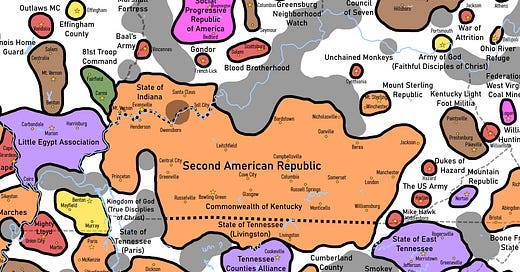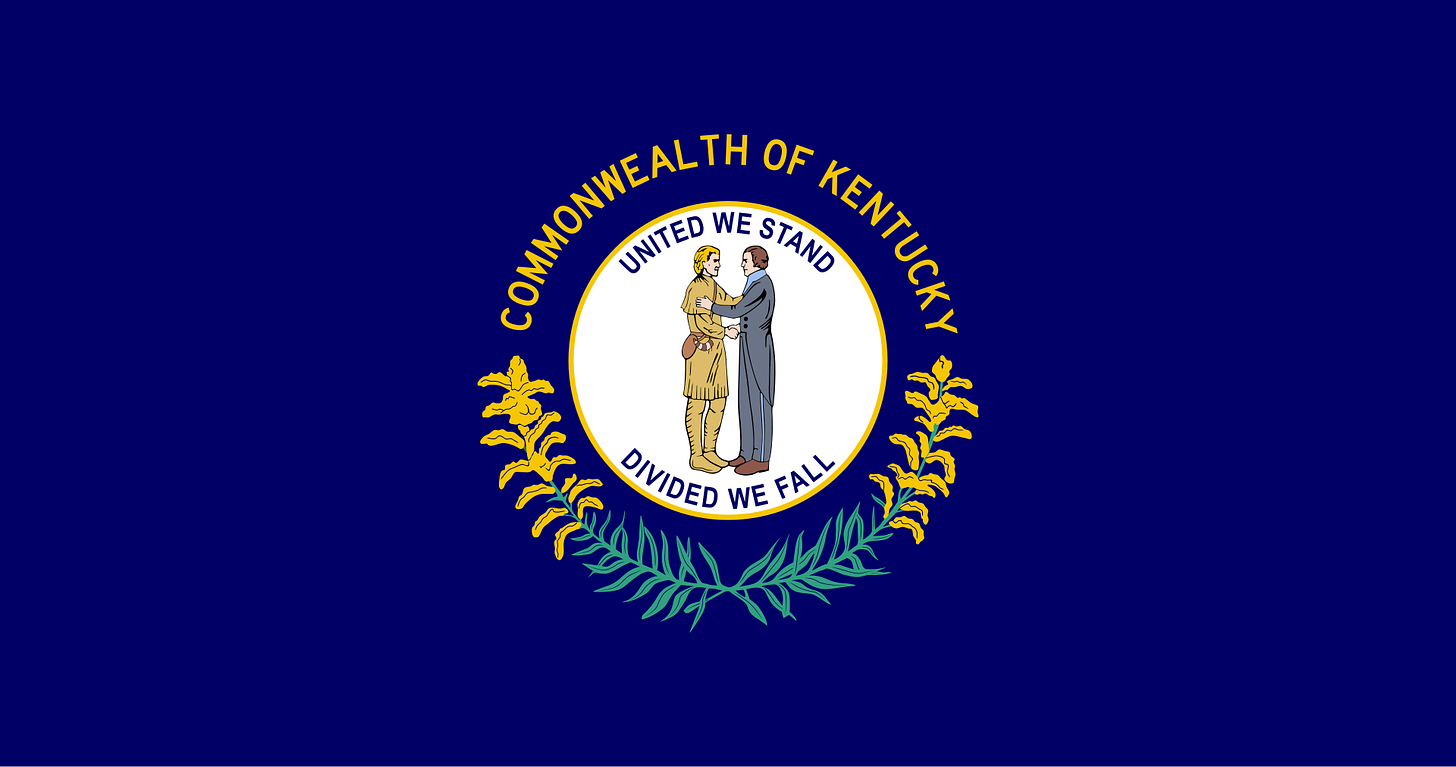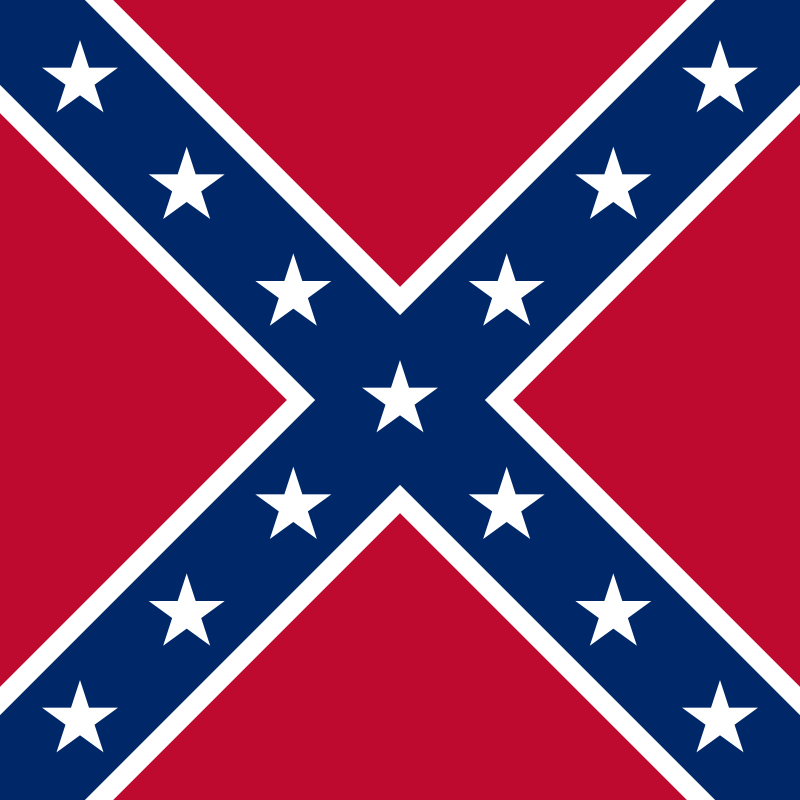The Fallen Continent: Kentucky
Home of the powerful Second American Republic, with its bold and unorthodox vision for America's future. Around this star orbits several smaller factions, all trying to slow their advance.
Population: 510,000
Largest City: Bowling Green
The young folks roll on the little cabin floor,
All merry, all happy and bright:
By'n by Hard Times comes a knocking at the door,
Then my old Kentucky Home, good night.
Introduction
Most of Kentucky’s major cities were destroyed during the Great War, but a large portion of the state’s hinterland was left unscathed. Efforts to re-establish the state government, however, were disjointed and confused. The State Police tried to set up a government in Henderson, while surviving state legislators formed two rival administrations: one in Central City and the other in Somerset. The Somerset government was made up of legislators with a right-wing ideological bent and recognized the Regenerated Congress, while the Central City government was an oligarchic shelter state similar to the ones in Quincy, Illinois and Winner, South Dakota.
These rump governments all spent the Starving Time hunkered down, focused on protecting themselves, their families, and loyal inhabitants of the immediate surrounding areas. Somerset had a more proactive outlook than Central City or Henderson, but their rigid ideological bent and poor diplomacy prevented them from quickly reunifying the state. The end result was dozens of factions vying for power across central Kentucky, total anarchy in Cis-Appalachian Kentucky, and the starvation of most of the state’s remaining population.
Second American Republic
Capital: Bowling Green
Classification: Legitimist Warlord (Caste-based regime)
Commonwealth of Kentucky
Capital: Bowling Green
Classification: Legitimist Warlord (Caste-based regime)
Allegiance: Second American Republic
The Physician
Nobody paid much attention to Edmund Meryll before the apocalypse. He was just the general practitioner who plastered his face on all those billboards across the state. Those who noticed them liked to joke about how one man could need so many billboards, and quickly moved on to a different topic of conversation. Dr. Meryll always had an eye for publicity, however, and was able to leverage his brand awareness into a spot on the Bowling Green emergency council.
Bowling Green was positioned not far from the ruins of Nashville and the rest of central Tennessee, and received more than its share of refugees seeking haven as a result. Lacking the resources to provide for them all, the mayor ordered the police to turn them away with deadly force. Where the rest of the city council saw a catastrophe, the physician saw an opportunity. Calling on the connections he had made with a the city militia, he overthrew the government of Bowling Green and let the refugees in. Though the militiamen were upset at Meryll’s betrayal of their localist principles, the horde of refugees quickly overpowered them, displacing them as Dr. Meryll’s new base of support.
Edmund Meryll was not the first warlord to rise to power on the backs of refugees, but he had no intentions of being just another king of the vagabonds. During the darkest depths of the Starving Time, only Meryll—so he said—had the strength of will, the ingenuity, and the resolve to make the hard choices Bowling Green needed to survive. He promoted a strong system of social stratification, lifting up a new class of elites while condemning the least productive in society to death by starvation.
The First Citizen
He forged an army out of the survivors of the Starving Time and went on the offensive, conquering central Kentucky and toppling the rival state government in Central City. He selectively incorporated elements of the Central City government to form his own Commonwealth of Kentucky and used their remaining forces as an engine to fuel further conquests. Somerset presented a far greater challenge than Central City could ever hope to put up, but were isolated enough for Meryll’s Commonwealth to surround and destroy them. The third rival government was the last to fall. The State Police regime in Henderson had long since fallen into irrelevance and was commonly understood to be a satellite state of the 81st Troop Command’s military administration in Evansville, Indiana, right across the Ohio River. The Hoosiers presented the greatest military obstacle of all, but traitorous elements in the City of Santa Claus gave Meryll the perfect opportunity to cross the Ohio and expel the Guardsmen from Indiana.
After conquering Somerset but before he dealt the killing blow to Henderson, Edmund Meryll announced his national ambitions. He drafted a new constitution and proclaimed the birth of the Second American Republic: “a nation that does not hearken back to a mythical, imagined past, but instead reaches out toward a bright and glorious future.” Embedded within that constitution was the Table of Ranks, a social caste system that took already-present elements of social stratification in Meryll’s Kentucky and developed them into a society-defining order. Meryll’s Ranks system is loosely based on the concept of the Socio-Sexual Hierarchy that had gained some traction within certain intellectual circles prior to the Great War, although he repurposed it for his own ends, just like how he repurposed the government itself. Through the Table of Ranks, Edmund Meryll transformed his neo-feudal despotate into a caste-based dictatorship.
The Table of Ranks
At the top of the pyramid of Ranks is the First Citizen, the autocratic ruler of the Second American Republic. Any holder of the office, incumbent or emeritus, is granted legal immunity for life and a very handsome salary, among many other privileges. Just below him are the Alpha Citizens, the top magnates of the Republic. These are the elite statesmen and businessmen who, including the First Citizen, possess a slim majority of the country’s wealth. There are just below two hundred Alpha Citizens in the entire SAR.
Below the Alphas are the Bravos (Beta was used at first, but was later eschewed for certain connotations the word has garnered over the years), who make up the bulk of the country’s elite. Broadly speaking, these are the “1%” of the SAR. Clocking in at about 4,000 members, they and the Alpha Citizens make up the entirety of the SAR’s extremely small electorate. Although Bravo Citizens can vote, Alpha votes count five times more than Bravo votes.
In the middle of the System of Ranks are the Gammas, the civil service workers and intellectuals, and the Sigmas, the lower-ranking officers in the military and law enforcement systems of the Republic. Generally, these are the middlemen who keep the cogs of state machinery turning, and make up the upper echelons of the middle class. Gammas and Sigmas cannot vote, but they still have some legal, social, and economic privileges that the lower Ranks lack. Below them are Delta Citizens, the average free inhabitants of the Republic. They represent most of the middle class and what antebellum Americans would have called the “working class.”
Near the bottom are the Lambdas, the neo-serfs who mostly descend from penniless refugees who barely eked a living throughout the Starving Time. They do the bulk of the Republic’s dirty work, growing food, mining ores, and toiling in factories for the state and dominant corporations. At the very bottom are the Omegas, who technically aren’t included in the Table at all; they are the untouchables, convicts, and other outcasts who have virtually no privileges or rights whatsoever.
Caste-Based Governance
As the First Citizen of the Republic, Meryll tightly managed rationing as a means of control. All agricultural activity is overseen by the state, and food can only be obtained via a state-issued ration card. Rations, along with a plethora of other social, political, and economic privileges, are all dependent on one’s Rank. Misbehavior is punished by demotion to a lower Rank, with all the downsides that entails. Ranks are, by default, inherited from one’s highest-ranking parent (intermarriage between different Ranks demands special government permission), but there is a small degree of upward social mobility allowed for an exceptional few to rise up in the Table. The system is unwieldy and difficult to maintain, and often relies on brute force.
The Republic holds elections, but only the elite Alpha and Bravo Citizens are allowed to vote in the national plebiscites every four years to keep or reject the First Citizen. Naturally, this very small and privileged voter pool has near-unanimously voted for Edmund Meryll in every single election. Even after Meryll’s death, they have continued to support Meryll’s designated heir and favorite nephew, Jesse Meryll. Infrequent local elections are held in certain locales at the First Citizen’s discretion, which are only open to Alpha and Beta Citizens. Only Alphas and Betas are permitted to run as candidates, and can only do so with state approval. Most officials, however, are appointed by the state, rather than elected.
There are two other states in the Republic, Indiana and Tennessee, but these are effectively still neo-feudal bodies that are yet to fully implement the Table of Ranks or the Republic’s other idiosyncratic systems. Bowling Green’s hope is that they will eventually be properly integrated into the wider republic, at which point they will be totally subordinated to federal authority. The Second American Constitution already deprived the Commonwealth of Kentucky of most of its powers, which were transferred to the national government following the first round of elections. Most of the Commonwealth’s skilled personnel were taken by the national government, leading only a skeleton’s crew behind to theoretically govern state matters. In practice, the Commonwealth of Kentucky is a powerless organization whose purpose is to serve as a rubber stamp for the national government.
In terms of quality of life, the SAR’s closest companions can be found in the USA-Mt. Pleasant and the Provisional Government of California, but Bowling Green is, in general, a very odd and unique faction. Also like the USA-Mt. Pleasant, they are the bogeyman of the surrounding region, and most inter-factional foreign policy in their vicinity revolves around trying to build a coalition that can stop them. The SAR is certainly powerful—one of the most powerful factions east of the Mississippi—but their list of enemies grows longer by the day, and they just might bite off more than they can chew.
Mount Sterling Republic
Capital: Mt. Sterling
Classification: Legitimist Warlord (Oligarchic republic)
The Mount Sterling Republic (Capital: Mount Sterling) is one of those small yet highly capable legitimist warlord states. The Republic’s Consul combines tactical battlefield skill with autocratic political rule, backed by a “Senate” of community leaders. He’s a serious thorn in Bowling Green’s side, launching hit and run raids across the SAR’s overextended eastern frontier. As is common with some small warlord factions, their sphere of influence and ability to project power is stronger than it appears on the map.
Aiding their quest to resist the SAR is a strong working relationship with the Army of God in Portsmouth, Ohio. Mt. Sterling isn’t thrilled about having to work with the fundamentalists, but they’re aware of their strong popular support in the region and can appreciate the value of having a guerilla army on their side. They can’t quite push back against the SAR yet, but they’ve slowed their progress in northeast Kentucky down to a crawl.
Unchained Monkeys
Capital: Cynthiania
Classification: Warlord (Raider gang)
The Unchained Monkeys are a raucous gang based out of the town of Cynthiana, dangerously close to a large blanket of fallout from the many Ohio River exclusion zones. They used to dwell within the NEZ itself, but built up enough strength to oust the previous rulers of Cynthiana, who had shot themselves in the foot through ceaseless infighting. The Monkeys’ raids throughout the countryside have been growing less and less fruitful recently, due to stiff resistance from the Army of God’s many supporters in the region. While Mt. Sterling appeased the fundamentalists with a cooperative approach, the Unchained Monkeys have simply tried to double down on suppressing religious militants, and it’s only emboldened the resistance movement.
Kentucky Light Foot Militia
Capital: Pikeville
Classification: Right-Wing Ideological Faction (Right-wing militia regime)
The Kentucky Light Foot Militia used to recognize the state government in Somerset, before the town was captured by Meryll’s forces. Likewise, they once recognized the Regenerated Congress of Hattiesburg, Mississippi, which the Somerset government participated in from a distance before the disjointed pan-rightist coalition fell apart.
Now that Somerset and the Regenerated Congress are gone, these auxiliary militiamen have to go it alone as east Kentucky’s most powerful faction. Truth be told, they aren’t entirely isolated, as they are trying to put together an alliance of like-minded militia regimes and sympathetic warlords in the region, including the Mount Sterling Republic, West Virginia Constitutional Militia, and Secret Patriotic Army. They even sent a delegation to Roanoke, Virginia to meet with the PALS, but upon returning to Pikeville, the ambassador strongly discouraged ever contacting Roanoke ever again.
Dukes of Hazard
Capital: Hazard
Classification: Warlord (Raider gang)
The Dukes of Hazard might not know anything about Sheriff Roscoe or jumping cars over ledges, but they are a tough little gang that’s earned their place among the east Kentuckian warlords. And frankly, they’re a lot smarter than the brainchild raider gang that ruled the town before they came along. Thirty years ago, there was a conversation that ran somewhat thus:
“Woah, dude. That town we just took over? It’s called Hazard. Pretty sick name, right? But like, what if WE called ourselves that? Because we’re, like, hazardous, to people who piss us off, or something.” “Yeah man, that sounds legit. Let’s try it.”
The US Army
Capital: Harlan
Classification: Warlord (Militaristic warlord gang)
Run and hide: the US Army’s arrived in Harlan! But don’t get confused—it’s just a name. They at least try to look the part, scavenging surplus uniforms from old stores and depots and stealing the uniforms off of dead Guardsmen and militiamen when they can. They’re a ragtag bunch, but they’re decently powerful relative to their size. There’s a reason they’ve been able to resist the SAR’s advance for as long as they have.
Mike Hawk
Capital: Middlesboro
Classification: Warlord (Personalistic warlord gang)
Mike Hawk is an incredibly mature and serious warlord who captured the town of Middlesboro.
Kingdom of God (True Disciples of Christ)
Capital: Benton
Classification: Religious Faction (Messianic cult)
The only faction in Kentucky west of Bowling Green is the Kingdom of God of the True Disciples of Christ, led by a self-proclaimed Messiah and Second Coming of Jesus Christ. Aside from the delusion of their Messianic cultism in the first place, this Kingdom of God plays it relatively safe with their theology and has not tried to blend it with esoteric or eastern mystic elements. They can broadly be described as Charismatics, although there are plenty of Charismatics in Kentucky who do not recognize the True Disciples of Christ.
Situated in an area now known as “the Cauldron,” thanks to its surrounding rivers and NEZs, the Kingdom’s natural defenses ward off the SAR, allowing them to focus on consolidating their gains in western Kentucky and prepare for expansion into Tennessee. Mighty Lloyd has thrown a monkey wrench into their plans, however, as he is far stronger and far more stubborn than the small fry warlords they’ve already subjugated. Still, they’ve gotten further than many other theocratic factions.
Index
Click here to read the master post of the series, with links at the bottom of the page to all other Fallen Continent entries.
Previous Post: West Virginia
Next Post: Tennessee












Missed opportunity to call the Hazard warlord "The Duke of Hazard."
God bless those idiots in Hazard. I hope they and Mike Hawk survive.
Does Kentucky still have a reputation for horses?